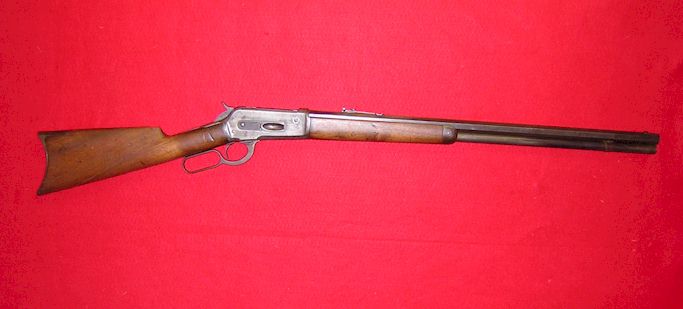
 |

![]()
Introduction | History of Winchester Guns | Models |
Variations
Outline of Features | Condition |
Diagrams / Pictures |
![]()
Which Model-Configuration of 1886 Rifle do You Have?Step 1: Determine the Model of firearm There are 3 Model Configurations with several variations within the 1886 Winchester. The standard 1886 rifle is a lever action and has a straight walnut stock, with a crescent buttplate. Deluxe varieties have checkered forearms and stocks, and may have a pistol grip and/or other added features, as many different options were available directly from the Winchester factory. There are a number of criteria (e.g., caliber, forearm wood, barrel length) that you will use to help identify the model of your 1886 Winchester. Barrel length is one of the most important (and difficult) criteria that will be used to differentiate among the 3 different Model Configurations of the 1886 Winchester. Barrel length is measured from the end of the barrel tip (near the front sight), to the end of the barrel threads (beyond where the barrel inserts into the receiver in the middle of the gun - see picture below for location). In the 1886 Winchester, you can measure from the top of the receiver from where the bolt opening ends, to the barrel tip, to obtain an accurate overall barrel length. As an example, in the Carbine which has a 22" barrel, the measurement from the barrel tip to the receiver front is only 21 1/4". In order to add the distance of the barrel threads, you need to keep measuring into the receiver until you reach the end of the threads at the bolt/receiver opening (see where arrow points to in picture below). This will give you the correct barrel length measurement.
Use the following Key to determine which model (configuration) of gun that you have. Start at "a" and then select one of the "a" choices. Follow the STEPS through the key to determine your rifle type. Then confirm with the overall descriptions and variations. These guns were very popular and some have gone through many hands. Each owner has had an opportunity to modify that gun, add parts, change parts, and remove features. Be alert for such modifications, and remember that any modification from the original probably decreases value. If you need help determining names used for the parts of your gun, examine the Parts Diagram by Clicking Here. |
|
|||||||||
|
Easy Key: a. My gun is a lever action with a barrel that is
LESS THAN 30" in length .
---
Go to section b
b. My gun has a barrel that has a magazine hanger and NO BARREL BAND --- Go to section c
b. My gun is a lever action with a barrel band, fixed front sight, no
forearm metal cap, and is NOT over 22" long . The barrel will be
round, the stock plain walnut, and the buttplate will be carbine style.
The forearm is also plain walnut, uncapped, and with a single barrel band.
The gun is blued, and can be fitted with a saddle ring
on the left receiver side.
c. My gun has at least a 22" barrel, has a magazine
hanger (in a dove-tail cut into the lower barrel) that holds the outer
magazine tube, has a walnut stock and
a crescent butt plate, and the front sight fits into a dove-tail cut into the
barrel. Click Here to go Back to Previous Page
|